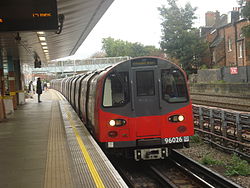Fleet line
| Jubilee line | |
|---|---|

Jubilee Line 1996 Stock 96026
|
|
| Overview | |
| Type | Deep Tube, sub surface |
| System | London Underground |
| Stations | 27 |
| Ridership | 213.554 million (2011/12) passenger journeys |
| Colour on map | Silver |
| Website | tfl.gov.uk |
| Operation | |
| Opened | 1979 |
| Depot(s) | Neasden, Stratford Market |
| Rolling stock |
7 carriages per trainset |
| Technical | |
| Line length | 36.2 km (22.5 mi) |
| Track gauge | 4 ft 8 1⁄2 in (1,435 mm) |
The Jubilee line is a London Underground line. Opened in 1979, it is the newest line on the network, although some sections of track date back to 1932 and some stations to 1879. Its western end beyond Baker Street was previously the Stanmore branch of the Bakerloo line, while the new build was completed in two major sections: initially in 1979 to Charing Cross tube station in central London; then extended in 1999 with the Jubilee Line Extension to Stratford station in east London. The later stations are larger and have special safety features, both aspects being attempts to future-proof the line. Following the extension into east London, serving areas once poorly connected to the Underground, the line has seen a huge growth in passenger numbers and is currently the third busiest on the network, with over 213 million passengers per year. The Jubilee line is coloured silver/grey on the Tube map, to mark the Silver Jubilee of Elizabeth II after which the line was named.
Between Finchley Road and Wembley Park, the Jubilee line shares its route with the Metropolitan line and Chiltern Main Line. Between Canning Town and Stratford, the line runs parallel to the Stratford International branch of the Docklands Light Railway.
In 1932, the Metropolitan Railway built a branch from its main line at Wembley Park to Stanmore. The line, as with many others in the northwest London area, was designed to absorb commuter traffic from the new and rapidly expanding suburbs. The line presented the Metropolitan with a problem – so successful was the suburban traffic that, by the early 1930s, the lines into Baker Street were becoming overloaded, a problem which was exacerbated by the post-war flight from the City of London to the West End of London.
...
Wikipedia
